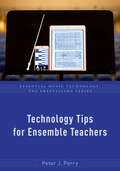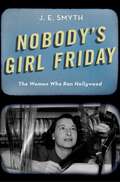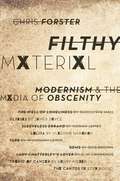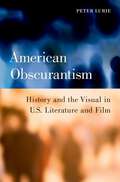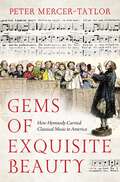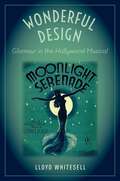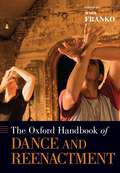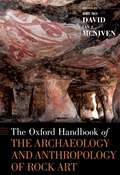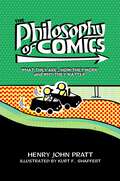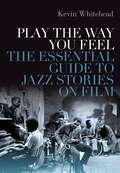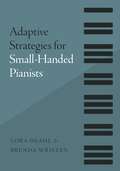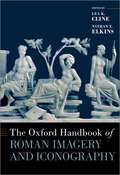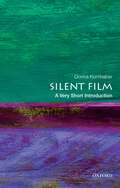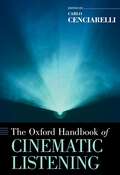- Table View
- List View
Technology Tips for Ensemble Teachers (Essential Music Technology:The Prestissimo Series)
by Peter J. PerryWritten by veteran music educator Peter J. Perry, Technology Tips for Ensemble Teachers presents a collection of practical tips to help today's school music ensemble director incorporate and implement technology in all aspects of large ensemble instruction. This go-to guide offers specific methods for the use of technology in ensemble instruction, identifies applicable technologies, and details proven ways to successfully use those technologies in instruction. Tips throughout the book vary in type and complexity, allowing directors of all technical abilities to use the book effectively to meet the unique needs of their ensembles and students. They also offer content-specific examples for technologies in band, orchestra, jazz ensemble, and chorus instruction, as well as emerging ensemble settings such as percussion ensembles, guitar ensembles, rock bands, a capella groups, and iPad ensembles. With a special focus on current technologies including mobile devices, Technology Tips for Ensemble Teachers is a timely and useful resource for directors as students and classrooms become ever more technology-oriented.
TECH TIPS FOR ENSEMBLE TEACHERS EMT C (Essential Music Technology:The Prestissimo Series)
by Peter J. PerryWritten by veteran music educator Peter J. Perry, Technology Tips for Ensemble Teachers presents a collection of practical tips to help today's school music ensemble director incorporate and implement technology in all aspects of large ensemble instruction. This go-to guide offers specific methods for the use of technology in ensemble instruction, identifies applicable technologies, and details proven ways to successfully use those technologies in instruction. Tips throughout the book vary in type and complexity, allowing directors of all technical abilities to use the book effectively to meet the unique needs of their ensembles and students. They also offer content-specific examples for technologies in band, orchestra, jazz ensemble, and chorus instruction, as well as emerging ensemble settings such as percussion ensembles, guitar ensembles, rock bands, a capella groups, and iPad ensembles. With a special focus on current technologies including mobile devices, Technology Tips for Ensemble Teachers is a timely and useful resource for directors as students and classrooms become ever more technology-oriented.
Nobody's Girl Friday: The Women Who Ran Hollywood
by J. E. SmythLooking back on her career in 1977, Bette Davis remembered with pride, "Women owned Hollywood for twenty years." She had a point. Between 1930 and 1950, over 40% of film industry employees were women, 25% of all screenwriters were female, one woman ran MGM behind the scenes, over a dozen women worked as producers, a woman headed the Screen Writers Guild three times, and press claimed Hollywood was a generation or two ahead of the rest of the country in terms of gender equality and employment. The first comprehensive history of Hollywood's high-flying career women during the studio era, Nobody's Girl Friday covers the impact of the executives, producers, editors, writers, agents, designers, directors, and actresses who shaped Hollywood film production and style, led their unions, climbed to the top during the war, and fought the blacklist. Based on a decade of archival research, author J.E. Smyth uncovers a formidable generation working within the American film industry and brings their voices back into the history of Hollywood. Their achievements, struggles, and perspectives fundamentally challenge popular ideas about director-based auteurism, male dominance, and female disempowerment in the years between First and Second Wave Feminism. Nobody's Girl Friday is a revisionist history, but it's also a deeply personal, collective account of hundreds of working women, the studios they worked for, and the films they helped to make. For many years, historians and critics have insisted that both American feminism and the power of women in Hollywood declined and virtually disappeared from the 1920s through the 1960s. But Smyth vindicates Bette Davis's claim. The story of the women who called the shots in studio-era Hollywood has never fully been told-until now.
Nobody's Girl Friday: The Women Who Ran Hollywood
by J. E. SmythLooking back on her career in 1977, Bette Davis remembered with pride, "Women owned Hollywood for twenty years." She had a point. Between 1930 and 1950, over 40% of film industry employees were women, 25% of all screenwriters were female, one woman ran MGM behind the scenes, over a dozen women worked as producers, a woman headed the Screen Writers Guild three times, and press claimed Hollywood was a generation or two ahead of the rest of the country in terms of gender equality and employment. The first comprehensive history of Hollywood's high-flying career women during the studio era, Nobody's Girl Friday covers the impact of the executives, producers, editors, writers, agents, designers, directors, and actresses who shaped Hollywood film production and style, led their unions, climbed to the top during the war, and fought the blacklist. Based on a decade of archival research, author J.E. Smyth uncovers a formidable generation working within the American film industry and brings their voices back into the history of Hollywood. Their achievements, struggles, and perspectives fundamentally challenge popular ideas about director-based auteurism, male dominance, and female disempowerment in the years between First and Second Wave Feminism. Nobody's Girl Friday is a revisionist history, but it's also a deeply personal, collective account of hundreds of working women, the studios they worked for, and the films they helped to make. For many years, historians and critics have insisted that both American feminism and the power of women in Hollywood declined and virtually disappeared from the 1920s through the 1960s. But Smyth vindicates Bette Davis's claim. The story of the women who called the shots in studio-era Hollywood has never fully been told-until now.
Filthy Material: Modernism and the Media of Obscenity
by Chris ForsterModernist literature is inextricable from the history of obscenity. The trials of figures like James Joyce, D. H. Lawrence, and Radclyffe Hall loom large in accounts twentieth century literature. Filthy Material: Modernism and The Media of Obscenity reveals the ways that debates about obscenity and literature were shaped by changes in the history of media. Judgments about obscenity, which hinged on understanding how texts were circulated and read, were often proxies for the changing place of literature in an age of new technological media. The emergence of film, photography, and new printing technologies shaped how literary value was understood, altering how obscenity was defined and which texts were considered obscene. Filthy Material rereads the history of obscenity in order to discover a history of technological media behind debates about moral corruption and sexual explicitness. The shift from the intense censorship of the early twentieth century to the effective 'end of obscenity' for literature at the middle of the century, it argues, is not simply a product of cultural liberalization but of a changing media ecology. Filthy Material brings together media theory and archival research to offer a fresh account of modernist obscenity and novel readings of works of modernist literature. It sheds new light on figures at the center of modernism's obscenity trials (such as Joyce and Lawrence), demonstrates the relevance of the discourse obscenity to understanding figures not typically associated with obscenity debates (like T. S. Eliot and Wyndham Lewis), and introduces new figures to our account of modernism (like Norah James and Jack Kahane). It reveals how modernist obscenity reflected a contest over the literary in the face of new media technologies.
FILTHY MATER MOD & MEDIA OF OBSCENITY C: Modernism and the Media of Obscenity
by Chris ForsterModernist literature is inextricable from the history of obscenity. The trials of figures like James Joyce, D. H. Lawrence, and Radclyffe Hall loom large in accounts twentieth century literature. Filthy Material: Modernism and The Media of Obscenity reveals the ways that debates about obscenity and literature were shaped by changes in the history of media. Judgments about obscenity, which hinged on understanding how texts were circulated and read, were often proxies for the changing place of literature in an age of new technological media. The emergence of film, photography, and new printing technologies shaped how literary value was understood, altering how obscenity was defined and which texts were considered obscene. Filthy Material rereads the history of obscenity in order to discover a history of technological media behind debates about moral corruption and sexual explicitness. The shift from the intense censorship of the early twentieth century to the effective 'end of obscenity' for literature at the middle of the century, it argues, is not simply a product of cultural liberalization but of a changing media ecology. Filthy Material brings together media theory and archival research to offer a fresh account of modernist obscenity and novel readings of works of modernist literature. It sheds new light on figures at the center of modernism's obscenity trials (such as Joyce and Lawrence), demonstrates the relevance of the discourse obscenity to understanding figures not typically associated with obscenity debates (like T. S. Eliot and Wyndham Lewis), and introduces new figures to our account of modernism (like Norah James and Jack Kahane). It reveals how modernist obscenity reflected a contest over the literary in the face of new media technologies.
American Obscurantism: History and the Visual in U.S. Literature and Film
by Peter LurieAmerican Obscurantism argues for a salutary indirection in U.S. culture. From its earliest canonical literary works through late twentieth and early twenty-first century film, the most compelling manifestations of America's troubled history have articulated this content through a unique formal and tonal obscurity. Envisioning the formidable darkness attending racial history at nearly every stage of the republic's founding and ongoing development, writers such as William Faulkner and Hart Crane or directors like the Coen brothers and Stanley Kubrick present a powerful critique of American conquest, southern plantation culture, and western frontier ideology. The book traces this arc from one of visual history's notoriously troubled texts: D.W. Griffith's The Birth of a Nation (1915). American Obscurantism engages the basis of these explorations in Poe and Melville, each of whom present notable occlusions in characters' racial understanding, an obtuseness or naïveté that is expressed by a corresponding formal opacity. Such oblique historicity as the book describes allows a method at odds with - and implicitly critical of - the historicizing trend that marked literary studies in the wake of the theoretical turn. Citing critiques such as those of Tim Dean and others of efforts to politicize literary and cultural studies, this book restores an emphasis on aesthetic and medium-specific features to argue for a formalist historicity. Working through challenges to an implicitly white-,bourgeois, heteronormative polity, American Obscurantism posits an insistent, vital racial otherness at the heart of American literature and cinema. It examines this pattern across a canon that shows more self-doubt than assuredness, arguing for the value of openness and questioning in place of epistemological or critical certainty. Following the insistence on a lamenting historical look back in the cases of Faulkner, Kubrick, and the Coens, the book ends by linking Crane's famous optimism in The Bridge, one rooted in an ecstatic celebrating of the body and an optimism attending "America" as both concept and nation-state, to the contemporary digital turn and the hope for a more inclusive visual culture as well as racial vision.
Gems of Exquisite Beauty: How Hymnody Carried Classical Music to America
by Peter Mercer-TaylorIn the decades leading up to the Civil War, most Americans probably encountered European classical music primarily through hymn tunes. Hymnody was the most popular and commercially successful genre of the antebellum period in the United States, and the unquenchable thirst for new tunes to sing led to a phenomenon largely forgotten today: in their search for fresh material, editors lifted hundreds of tunes from the works of major classical composers to use as settings of psalms and hymns. The few that remain popular today millions have sung "Joyful, Joyful We Adore Thee" to Beethoven and "Hark, The Herald Angels Sing" to Mendelssohn are vestiges of one of the most distinctive trends in antebellum music-making. Gems of Exquisite Beauty is the first in-depth study of the historical rise and fall of this adaptation practice, its artistic achievements, and its place in nineteenth-century American musical life. It traces the contributions of pioneering figures like Arthur Clifton and the impact of bestsellers like the Handel and Haydn Society Collection, which helped turn Lowell Mason into America's most influential musician. By telling the tales of these hymns and those who brought them into the world, author Peter Mercer-Taylor reveals a central part of the history of how the American public first came to meet and creatively engage with Europe's rich musical practices.
Gems of Exquisite Beauty: How Hymnody Carried Classical Music to America
by Peter Mercer-TaylorIn the decades leading up to the Civil War, most Americans probably encountered European classical music primarily through hymn tunes. Hymnody was the most popular and commercially successful genre of the antebellum period in the United States, and the unquenchable thirst for new tunes to sing led to a phenomenon largely forgotten today: in their search for fresh material, editors lifted hundreds of tunes from the works of major classical composers to use as settings of psalms and hymns. The few that remain popular today millions have sung "Joyful, Joyful We Adore Thee" to Beethoven and "Hark, The Herald Angels Sing" to Mendelssohn are vestiges of one of the most distinctive trends in antebellum music-making. Gems of Exquisite Beauty is the first in-depth study of the historical rise and fall of this adaptation practice, its artistic achievements, and its place in nineteenth-century American musical life. It traces the contributions of pioneering figures like Arthur Clifton and the impact of bestsellers like the Handel and Haydn Society Collection, which helped turn Lowell Mason into America's most influential musician. By telling the tales of these hymns and those who brought them into the world, author Peter Mercer-Taylor reveals a central part of the history of how the American public first came to meet and creatively engage with Europe's rich musical practices.
Wonderful Design: Glamour in the Hollywood Musical
by Lloyd WhitesellAs one of the most beloved and beguiling genres of entertainment, the film musical wears its style ostentatiously. The genre allows for hyperbolic expression, extravagant sonic and visual decor, and extremely stylized forms of movement and performance. By staging a glittering spectacle, by releasing a current of lush sentiment, by unveiling a world of elegance and romance, the film musical woos us with patterns, textures, finesse and sensory display. In this book, author Lloyd Whitesell asks what, exactly, makes film musicals so glamorous. As he argues, glamour projects an aura of ethereality or sophistication by way of suave deportment, sensuous textures, elevated styles, and aesthetically refined effects. Glamour, in other words, is what unites "Cheek to Cheek" from Top Hat and the title song from Beauty and the Beast, each a sonic evocation of luxury, sparkle, grace, and finesse. Whitesell redirects our attention from visual cues like sequins and evening gloves to explore how glamour resides in the sonic. Discussing dozens of musical numbers, analyzing ingenious orchestration, and appraising the distinctive styles of favorite musical stars, Whitesell illuminates fundamental traits of the genre, its aesthetic strategies, and cultural ambitions.
WONDERFUL DESIGN C: Glamour in the Hollywood Musical
by Lloyd WhitesellAs one of the most beloved and beguiling genres of entertainment, the film musical wears its style ostentatiously. The genre allows for hyperbolic expression, extravagant sonic and visual decor, and extremely stylized forms of movement and performance. By staging a glittering spectacle, by releasing a current of lush sentiment, by unveiling a world of elegance and romance, the film musical woos us with patterns, textures, finesse and sensory display. In this book, author Lloyd Whitesell asks what, exactly, makes film musicals so glamorous. As he argues, glamour projects an aura of ethereality or sophistication by way of suave deportment, sensuous textures, elevated styles, and aesthetically refined effects. Glamour, in other words, is what unites "Cheek to Cheek" from Top Hat and the title song from Beauty and the Beast, each a sonic evocation of luxury, sparkle, grace, and finesse. Whitesell redirects our attention from visual cues like sequins and evening gloves to explore how glamour resides in the sonic. Discussing dozens of musical numbers, analyzing ingenious orchestration, and appraising the distinctive styles of favorite musical stars, Whitesell illuminates fundamental traits of the genre, its aesthetic strategies, and cultural ambitions.
The Oxford Handbook of Dance and Reenactment (Oxford Handbooks)
by Mark FrankoThe Oxford Handbook of Dance and Reenactment brings together a cross-section of artists and scholars engaged with the phenomenon of reenactment in dance from a practical and theoretical standpoint. Synthesizing myriad views on danced reenactment and the manner in which this branch of choreographic performance intersects with important cultural concerns around appropriation this Handbook addresses originality, plagiarism, historicity, and spatiality as it relates to cultural geography. Others topics treated include transmission as a heuristic device, the notion of the archive as it relates to dance and as it is frequently contrasted with embodied cultural memory, pedagogy, theory of history, reconstruction as a methodology, testimony and witnessing, theories of history as narrative and the impact of dance on modernist literature, and relations of reenactment to historical knowledge and new media.
The Oxford Handbook of the Archaeology and Anthropology of Rock Art (Oxford Handbooks)
Rock art is one of the most visible and geographically widespread of cultural expressions, and it spans much of the period of our species' existence. Rock art also provides rare and often unique insights into the minds and visually creative capacities of our ancestors and how selected rock outcrops with distinctive images were used to construct symbolic landscapes and shape worldviews. Equally important, rock art is often central to the expression of and engagement with spiritual entities and forces, and in all these dimensions it signals the diversity of cultural practices, across place and through time. Over the past 150 years, archaeologists have studied ancient arts on rock surfaces, both out in the open and within caves and rock shelters, and social anthropologists have revealed how people today use art in their daily lives. The Oxford Handbook of the Archaeology and Anthropology of Rock Art showcases examples of such research from around the world and across a broad range of cultural contexts, giving a sense of the art's regional variability, its antiquity, and how it is meaningful to people in the recent past and today - including how we have ourselves tended to make sense of the art of others, replete with our own preconceptions. It reviews past, present, and emerging theoretical approaches to rock art investigation and presents new, cutting-edge methods of rock art analysis for the student and professional researcher alike.
The Oxford Handbook of the Archaeology and Anthropology of Rock Art (Oxford Handbooks)
by Bruno David and Ian J. McnivenRock art is one of the most visible and geographically widespread of cultural expressions, and it spans much of the period of our species' existence. Rock art also provides rare and often unique insights into the minds and visually creative capacities of our ancestors and how selected rock outcrops with distinctive images were used to construct symbolic landscapes and shape worldviews. Equally important, rock art is often central to the expression of and engagement with spiritual entities and forces, and in all these dimensions it signals the diversity of cultural practices, across place and through time. Over the past 150 years, archaeologists have studied ancient arts on rock surfaces, both out in the open and within caves and rock shelters, and social anthropologists have revealed how people today use art in their daily lives. The Oxford Handbook of the Archaeology and Anthropology of Rock Art showcases examples of such research from around the world and across a broad range of cultural contexts, giving a sense of the art's regional variability, its antiquity, and how it is meaningful to people in the recent past and today - including how we have ourselves tended to make sense of the art of others, replete with our own preconceptions. It reviews past, present, and emerging theoretical approaches to rock art investigation and presents new, cutting-edge methods of rock art analysis for the student and professional researcher alike.
The Philosophy of Comics: What They Are, How They Work, and Why They Matter
by Henry John PrattHow do comics produce such a striking range of vibrant stories, representations, and expressions of the sensibilities of their creators? Henry John Pratt's The Philosophy of Comics provides a ground-breaking, illustrated introduction to the study of comics and graphic novels, advancing the field of comics studies by attending to some of its most notable problems. Pratt examines the history of comics, the contrast between comics and cartoons, the tenuous place of comics in the art world, and what it is to be a comic in the first place. Comics work through extensive modes of representation and expression, including through film, non-graphic literature, and theatre. Pratt examines questions such as, why and how are so many films based on comics? Can there be a perfect adaptation from one to the other? Are some comics better than others? Why is reading comics not regarded in the same light as reading literary books? Pratt urges us to look closely at the most significant problems and puzzles that comics provoke, having to do with the very nature of comics, what composes them, how comics are related to other art forms, how they function to manage space and time in storytelling, and why they've been neglected in academic circles despite being a culturally significant art form for decades. With illustrations by Kurt F. Shaffert, The Philosophy of Comics ultimately tries to explain the true underlying value of comics as an art form.
The Philosophy of Comics: What They Are, How They Work, and Why They Matter
by Henry John PrattHow do comics produce such a striking range of vibrant stories, representations, and expressions of the sensibilities of their creators? Henry John Pratt's The Philosophy of Comics provides a ground-breaking, illustrated introduction to the study of comics and graphic novels, advancing the field of comics studies by attending to some of its most notable problems. Pratt examines the history of comics, the contrast between comics and cartoons, the tenuous place of comics in the art world, and what it is to be a comic in the first place. Comics work through extensive modes of representation and expression, including through film, non-graphic literature, and theatre. Pratt examines questions such as, why and how are so many films based on comics? Can there be a perfect adaptation from one to the other? Are some comics better than others? Why is reading comics not regarded in the same light as reading literary books? Pratt urges us to look closely at the most significant problems and puzzles that comics provoke, having to do with the very nature of comics, what composes them, how comics are related to other art forms, how they function to manage space and time in storytelling, and why they've been neglected in academic circles despite being a culturally significant art form for decades. With illustrations by Kurt F. Shaffert, The Philosophy of Comics ultimately tries to explain the true underlying value of comics as an art form.
Play the Way You Feel: The Essential Guide to Jazz Stories on Film
by Kevin WhiteheadJazz stories have been entwined with cinema since the inception of jazz film genre in the 1920s, giving us origin tales and biopics, spectacles and low-budget quickies, comedies, musicals, and dramas, and stories of improvisers and composers at work. And the jazz film has seen a resurgence in recent years--from biopics like Miles Ahead and HBO's Bessie, to dramas Whiplash and La La Land. In Play the Way You Feel, author and jazz critic Kevin Whitehead offers a comprehensive guide to these films and other media from the perspective of the music itself. Spanning 93 years of film history, the book looks closely at movies, cartoons, and a few TV shows that tell jazz stories, from early talkies to modern times, with an eye to narrative conventions and common story points. Examining the ways historical films have painted a clear picture of the past or overtly distorted history, Play the Way You Feel serves up capsule discussions of sundry topics including Duke Ellington's social life at the Cotton Club, avant-garde musical practices in 1930s vaudeville, and Martin Scorsese's improvisatory method on the set of New York, New York. Throughout the book, Whitehead brings the same analytical bent and concise, witty language listeners know from his jazz segments on NPR's Fresh Air with Terry Gross. He investigates well-known songs, traces the development of the stock jazz film ending, and offers fresh, often revisionist takes on works by such directors as Howard Hawks, John Cassavetes, Shirley Clarke, Francis Ford Coppola, Clint Eastwood, Spike Lee, Robert Altman, Woody Allen and Damien Chazelle. In all, Play the Way You Feel is a feast for film-genre fanatics and movie-watching jazz enthusiasts.
Play the Way You Feel: The Essential Guide to Jazz Stories on Film
by Kevin WhiteheadJazz stories have been entwined with cinema since the inception of jazz film genre in the 1920s, giving us origin tales and biopics, spectacles and low-budget quickies, comedies, musicals, and dramas, and stories of improvisers and composers at work. And the jazz film has seen a resurgence in recent years--from biopics like Miles Ahead and HBO's Bessie, to dramas Whiplash and La La Land. In Play the Way You Feel, author and jazz critic Kevin Whitehead offers a comprehensive guide to these films and other media from the perspective of the music itself. Spanning 93 years of film history, the book looks closely at movies, cartoons, and a few TV shows that tell jazz stories, from early talkies to modern times, with an eye to narrative conventions and common story points. Examining the ways historical films have painted a clear picture of the past or overtly distorted history, Play the Way You Feel serves up capsule discussions of sundry topics including Duke Ellington's social life at the Cotton Club, avant-garde musical practices in 1930s vaudeville, and Martin Scorsese's improvisatory method on the set of New York, New York. Throughout the book, Whitehead brings the same analytical bent and concise, witty language listeners know from his jazz segments on NPR's Fresh Air with Terry Gross. He investigates well-known songs, traces the development of the stock jazz film ending, and offers fresh, often revisionist takes on works by such directors as Howard Hawks, John Cassavetes, Shirley Clarke, Francis Ford Coppola, Clint Eastwood, Spike Lee, Robert Altman, Woody Allen and Damien Chazelle. In all, Play the Way You Feel is a feast for film-genre fanatics and movie-watching jazz enthusiasts.
Adaptive Strategies for Small-Handed Pianists
by Lora Deahl Brenda WristenAdaptive Strategies for Small-Handed Pianists brings together information from biomechanics, ergonomics, physics, anatomy, medicine, and piano pedagogy to focus on the subject of small-handedness. The first comprehensive study of its kind, the book opens with an overview of historical, anatomical, and pedagogical perspectives and redresses long-held biases concerning those who struggle at the piano because of issues with hand size. A discussion of work efficiency, the human anatomy, and the constraints of physics serves as the theoretical basis for a focused analysis of healthy movement and piano technique as they relate to small-handedness. Separate chapters deal with specific alternative approaches: redistribution, refingering, strategies to maximize reach and power, and musical solutions for technical problems. Richly illustrated with hundreds of examples from a wide range of piano repertoire, the book is an incomparable resource for piano teachers and students, written in language that is accessible to a broad audience. It balances scholastic rigor with practical experience in the field to demonstrate that the unique physical and musical needs of the small-handed can be addressed in sensitive and appropriate ways.
The Oxford Handbook of Roman Imagery and Iconography (Oxford Handbooks)
Imagery and iconography served specific functions in public, private, and ritual spheres in the Roman world. State-sanctioned imagery communicated politically charged ideas through an often-complex pictorial language, composed of emblems and attributes that signaled aspects of policy. In the private sphere, imagery communicated ethnic, social, and religious identities through specific signs, symbols, and forms, and through the emulation of state-sanctioned art. This volume focuses primarily on visual imagery in the Roman world, examined by context and period, and the evolving scholarly traditions of iconographic analysis and visual semiotics that have framed the modern study of these images. Among other subjects, essays touch on iconography and style in republican and early imperial art, public sculpture and social practice in the Roman Empire, coin iconography, funerary imagery, imagery in ritual use, and images and interpretation of Africans in Roman art. The Oxford Handbook of Roman Imagery and Iconography is an important reference work for both the communicative value of images in the Roman world and the tradition of iconographical analysis.
The Oxford Handbook of Roman Imagery and Iconography (Oxford Handbooks)
by Lea K. Cline, Nathan T. ElkinsImagery and iconography served specific functions in public, private, and ritual spheres in the Roman world. State-sanctioned imagery communicated politically charged ideas through an often-complex pictorial language, composed of emblems and attributes that signaled aspects of policy. In the private sphere, imagery communicated ethnic, social, and religious identities through specific signs, symbols, and forms, and through the emulation of state-sanctioned art. This volume focuses primarily on visual imagery in the Roman world, examined by context and period, and the evolving scholarly traditions of iconographic analysis and visual semiotics that have framed the modern study of these images. Among other subjects, essays touch on iconography and style in republican and early imperial art, public sculpture and social practice in the Roman Empire, coin iconography, funerary imagery, imagery in ritual use, and images and interpretation of Africans in Roman art. The Oxford Handbook of Roman Imagery and Iconography is an important reference work for both the communicative value of images in the Roman world and the tradition of iconographical analysis.
Silent Film: A Very Short Introduction (Very Short Introductions)
by Donna KornhaberEncompassing the thirty-five year span between the initial development of film technology in the mid-1890s and the adoption of synchronized sound in the late 1920s, the cinema's silent era is both one of the most important epochs of film history and one of the most misunderstood within the popular imagination. In this brief and readable account, these formative decades come vividly to life. Covering the full scope of the silent era-from the invention of motion pictures to the rise of the Hollywood studios-and touching on films and filmmakers from every corner of the globe, Silent Film: A Very Short Introduction offers a window into film's first years as a worldwide entertainment phenomenon. From groundbreaking early shorts to the masterpieces of the cinema's classical era, from street-corner nickelodeons to grand movie palaces, from slapstick to the avant-garde, the silent era's artistic abundance and global variety are here put on full display. In the story of silent film, we see not just the origins of a new culture industry but also a legacy of imagination and innovation that continues to profoundly influence the cinema even to this day. ABOUT THE SERIES: The Very Short Introductions series from Oxford University Press contains hundreds of titles in almost every subject area. These pocket-sized books are the perfect way to get ahead in a new subject quickly. Our expert authors combine facts, analysis, perspective, new ideas, and enthusiasm to make interesting and challenging topics highly readable.
Silent Film: A Very Short Introduction (Very Short Introductions)
by Donna KornhaberEncompassing the thirty-five year span between the initial development of film technology in the mid-1890s and the adoption of synchronized sound in the late 1920s, the cinema's silent era is both one of the most important epochs of film history and one of the most misunderstood within the popular imagination. In this brief and readable account, these formative decades come vividly to life. Covering the full scope of the silent era-from the invention of motion pictures to the rise of the Hollywood studios-and touching on films and filmmakers from every corner of the globe, Silent Film: A Very Short Introduction offers a window into film's first years as a worldwide entertainment phenomenon. From groundbreaking early shorts to the masterpieces of the cinema's classical era, from street-corner nickelodeons to grand movie palaces, from slapstick to the avant-garde, the silent era's artistic abundance and global variety are here put on full display. In the story of silent film, we see not just the origins of a new culture industry but also a legacy of imagination and innovation that continues to profoundly influence the cinema even to this day. ABOUT THE SERIES: The Very Short Introductions series from Oxford University Press contains hundreds of titles in almost every subject area. These pocket-sized books are the perfect way to get ahead in a new subject quickly. Our expert authors combine facts, analysis, perspective, new ideas, and enthusiasm to make interesting and challenging topics highly readable.
The Oxford Handbook of Cinematic Listening (Oxford Handbooks)
The Oxford Handbook of Cinematic Listening explores the place of cinema in the history of listening. It looks at the ways in which listening to film is situated in textual, spatial, and social practices, and also studies how cinematic modes of listening have extended into other media and everyday experiences. Chapters are structured around six themes. Part I ("Genealogies and Beginnings") considers film sound in light of pre-existing practices such as opera and shadow theatre, and also explores changes in listening taking place at critical junctures in the early history of cinema. Part II ("Locations and Relocations") focuses on specific venues and presentational practices from roadshow movies to contemporary live-score screenings. Part III ("Representations and Re-Presentations") zooms into the formal properties of specific films, analyzing representations of listening on screen as well as the role of sound as a representational surplus. Part IV ("The Listening Body") focuses on the power of cinematic sound to engage the full body sensorium. Part V ("Listening Again") discusses a range of ways in which film sound is encountered and reinterpreted outside the cinema, whether through ancillary materials such as songs and soundtrack albums, or in experimental conditions and pedagogical contexts. Part VI ("Across Media") compares cinema with the listening protocols of TV series and music video, promenade theatre and personal stereos, video games and Virtual Reality.
The Oxford Handbook of Cinematic Listening (Oxford Handbooks)
by Carlo CenciarelliThe Oxford Handbook of Cinematic Listening explores the place of cinema in the history of listening. It looks at the ways in which listening to film is situated in textual, spatial, and social practices, and also studies how cinematic modes of listening have extended into other media and everyday experiences. Chapters are structured around six themes. Part I ("Genealogies and Beginnings") considers film sound in light of pre-existing practices such as opera and shadow theatre, and also explores changes in listening taking place at critical junctures in the early history of cinema. Part II ("Locations and Relocations") focuses on specific venues and presentational practices from roadshow movies to contemporary live-score screenings. Part III ("Representations and Re-Presentations") zooms into the formal properties of specific films, analyzing representations of listening on screen as well as the role of sound as a representational surplus. Part IV ("The Listening Body") focuses on the power of cinematic sound to engage the full body sensorium. Part V ("Listening Again") discusses a range of ways in which film sound is encountered and reinterpreted outside the cinema, whether through ancillary materials such as songs and soundtrack albums, or in experimental conditions and pedagogical contexts. Part VI ("Across Media") compares cinema with the listening protocols of TV series and music video, promenade theatre and personal stereos, video games and Virtual Reality.
